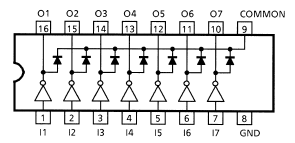Answer the question
In order to leave comments, you need to log in
Is it possible to combine outputs from a darlington assembly?
There is a ULN2003A chip.
It supports 500mA for each output, judging by the description. It is logical to assume that if we combine several outputs, we will get more than 500mA at the output (3A is needed), but there is a suspicion that due to the fact that the switching is still not instantaneous, the output may burn out (because the load is 3A, and the output of the microcircuit is 500mA).
I understand correctly?
If it really can burn out, what is better to use to control the load (3A LED strip, PWM is needed)? 
Answer the question
In order to leave comments, you need to log in
This particular chip is not suitable for you. She has a limit of 0.5A per output or 2.5A in total for the entire case. It is possible to combine the outputs of transistors, but with caution. The bipolar transistor has such a phenomenon as secondary (thermal) breakdown. If a larger current accidentally flows through one of the transistors (for example, due to a spread in parameters), then this transistor will heat up more than the others. The resistance of its pn-junction will decrease, the current through it will increase even more ... Puff! The magic smoke is out, the device no longer works.
To prevent this from happening, a current-leveling resistor (0.05..0.25 Ohm) is connected in series with each transistor. Resistors provide a falling I-V characteristic of the output and do not allow secondary breakdown to develop.
And I will advise you to use field-effect transistors (MOSFET). Some IRF540 will miss a dozen amps and not choke. And yes, field-effect transistors can be connected in parallel without any resistors. Their channel resistance increases with heating, the currents are automatically equalized.
Didn't find what you were looking for?
Ask your questionAsk a Question
731 491 924 answers to any question